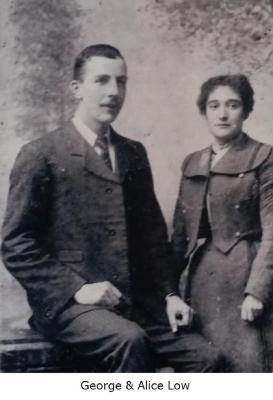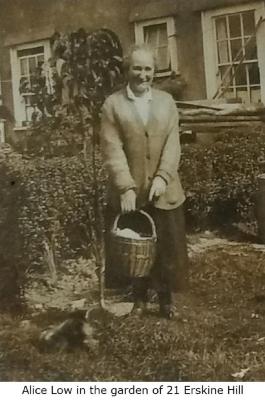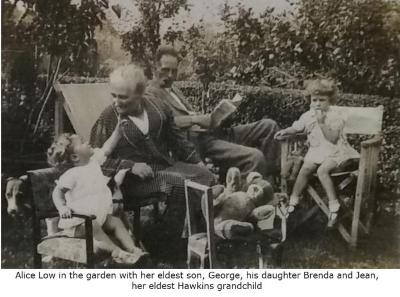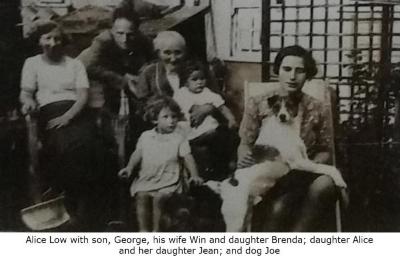To display in FULL SCREEN hover the cursor over the image above and click the top left zoom button
CORPORAL GEORGE LOW,
2nd Battalion, Essex Regiment
Reported missing in May 1917
He had seen military service in South Africa, arriving in Cape Town in March 1900 and being discharged from Warley in June 1901. He was awarded the South African Medal with 6 bars. In 1914 he volunteered again and was sent to France in 1916. In May 1917 he was reported missing after an attack on the chemical works near Roeux and Frampoux on the north side of the Scarfe. George Low left a wife and three young children at their home at 21 Erskine Hill. The family had been Free Church members from the early years where he is remembered on their war memorial. His name appears on a commemorative panel at the Arras memorial in the Faubourg-d’Amiens Cemetery. He has no known grave.
From his family:
Our Gran
Alice Low, widow of Corporal George Low of the Second Battalion of the Essex Regiment. Gran was there, in the home, for the childhood of her three Hawkins grandchildren. At first it was at 21 Erskine Hill, the home she had shared with her husband until his death in the Great War and which she afterwards shared with her daughter, Alice, who married Ernest Hawkins in 1932.
Gran was there, in the home, for the childhood of her three Hawkins grandchildren. At first it was at 21 Erskine Hill, the home she had shared with her husband until his death in the Great War and which she afterwards shared with her daughter, Alice, who married Ernest Hawkins in 1932.
Her two older grandchildren were born during the time at no.21, while the youngest was born when they had all moved to 51 Erskine Hill (which Alice and Ernest Hawkins had already arranged to rent) after a World War II bomb destroyed their first home.
We remember that she was always there. She was simply a part of our daily lives. She loved her family, especially her grandchildren, and loved to spend time with them. She was always knitting - all our cardigans and jumpers were made by her. She knitted socks - properly on four needles - and could produce the most intricate patterns.
She took Roger out in his pram, helped in the garden and with the household chores although we don’t remember her taking part in the cooking - that was Mum’s job. She spent a lot of time sewing, by hand and on the Singer treadle machine; probably making clothes for us all. She was a fixture in our lives and seemed very old, although she was only sixty-seven when she died. She was proud of the fact that her own mother had known Dame Henrietta Barnett during the family’s time in Whitechapel. She was fond of all of us but could be very strict. She felt that self-control was very important - we were not encouraged to give way to feelings. Bereavement should be accepted stoically; you should never do anything to make other people feel uncomfortable.
She was a fixture in our lives and seemed very old, although she was only sixty-seven when she died. She was proud of the fact that her own mother had known Dame Henrietta Barnett during the family’s time in Whitechapel. She was fond of all of us but could be very strict. She felt that self-control was very important - we were not encouraged to give way to feelings. Bereavement should be accepted stoically; you should never do anything to make other people feel uncomfortable.
She had had a hard life, widowed when quite young with three children to raise. As her husband was, at first, only reported as missing it was nearly three years before she received the pension she was entitled to and she worked as a postwoman to support her family. She was quietly determined and expected others to show similar qualities. She was one of the earliest members of the Free Church, a dedicated church-goer and went every week with Mum. She always had a bible by her bed. I think she had a comfortable, if noisy, life with us -1 hope so, at any rate. If anyone had asked us what she was like we’d just have said she was our Gran. I think we all wish now that we had known her better.
She was one of the earliest members of the Free Church, a dedicated church-goer and went every week with Mum. She always had a bible by her bed. I think she had a comfortable, if noisy, life with us -1 hope so, at any rate. If anyone had asked us what she was like we’d just have said she was our Gran. I think we all wish now that we had known her better.
Jean Clark, Frances Wilson
and Roger Hawkins